In several posts over the years here at Mormanity and on my website, I’ve noted that the arguments of our critics against LDS scriptures, our doctrines, and the Restoration are sometimes actually helpful. Sometimes they help us reconsider sloppy assumptions and improve our understanding of the scriptures or our history. Sometimes they drive us to study complex issues more carefully, perhaps even leading to new discoveries that turn apparent weaknesses into strengths. And sometimes they can unintentionally hand us gifts that help us overcome difficult challenges. One such gift can be found in an early “anti-Mormon” attack on the book of Abraham. I use the word “anti-Mormon” infrequently of late, but the introduction (shown below) to the unintentionally beneficent article in question mentions that one of the authors, Jerald Tanner, heads a “professedly anti-Mormon publishing house.” I suppose he did not object to the label and as perhaps the most famous if not most successful anti-Mormon crusader who made a career out of his passion, it’s probably a fair term. But my focus here is on the gift, not the givers.
For decades, a gift regarding the translation of the book of Abraham has been staring us in the face in the analysis provided by Grant S. Heward and Jerald Tanner in “The Source of the Book of Abraham,” Dialogue: A Journal of Mormon Thought 3/2 (1968): 92–97. This gift is not obvious until one reads their article and then looks again at Joseph’s commentary on Facsimile 2. The gift, though, seems to have remained unrecognized until the 2020 FairMormon Conference when Tim Barker gave a significant presentation pointing out what many of us should have recognized years ago. Tim’s presentation, “Translating the Book of Abraham: The Answer Under Our Heads,” is available (but behind a paywall) at the FairMormon Conference Streaming 2020 page for those who have purchased the $30 pass to watch the full set of videos from the conference. The transcript with images from the slides, however, is now available at FairMormon.com [link added 1/11/21]. Tim’s presentation is not yet on YouTube, unfortunately, but I’ll share a touch of the content and hope you’ll watch the entire presentation and the rest of a truly excellent conference.
First, here’s the introduction to Heward and Tanner’s article in a special 1968 edition of Dialogue devoted to book of Abraham issues shortly after the Joseph Smith Papyri were found in the Metropolitan Museum of Art (the Met) in New York City (click to enlarge):
Heward and Tanner make the basic argument against Joseph Smith as a translator by pointing out what nearly every attack on the book of Abraham today relies upon: there are book of Abraham manuscripts in which a few Egyptian characters from one of the Joseph Smith Papyri, now known as JSP XI (viewable on the Joseph Smith Papers website), are in the margins of the manuscripts, as if Joseph had translated each character to give large blocks of English text (sometimes about 200 words for 1 character). You can see these manuscripts on the Joseph Smith Papers website, where the three key documents with Egyptian characters on the left are called book of Abraham Manuscript A, Manuscript B, and Manuscript C. “Translating” many dozens of words from one character is not only utterly ridiculous, but now that ancient Egyptian can be read and translated, it is clear that the characters used have nothing to do with the book of Abraham text and in fact are part of the Book of Breathings. Thus, the book of Abraham is said to expose Joseph as an uninspired and ridiculous fraud. This argument, of course, relies on the assumption that the book of Abraham manuscripts in question are a “revelatory” work product giving us a “window” into how Joseph Smith allegedly translated a handful of characters into the book of Abraham.
Apologists have responded with a variety of arguments, often pointing out that JSP XI does not match the description of the scroll Joseph translated, that there were other scrolls that were sold after Joseph’s death and burned in the Great Chicago Fire that were not part of the tiny collection of fragments that survived (the missing scroll theory), or suggesting that the translation by revelation need not be directly from any of the scrolls that were in Joseph’s possession but may have been merely “catalyzed” by the papyri. It has also been argued that the manuscripts with Egyptian characters next to English text appear to be a product from the scribes done for unclear purposes after the translation had already been done, in which the characters might have been added as decorative elements, as mystic representations being explored in connection with W.W. Phelps’ fascination with the hypothesized “pure language” of the ancients, as scribal attempts to crack the Egyptian language based on their assumption that JSP XI must have some connection to the book of Abraham since Facs. 1 was physically connected to it, or as “reverse ciphers” to create a code to convey what was in the book of Abraham text. But we are still left with an apparent association of some kind between characters on JSP XI and the book of Abraham text. If they weren’t being translated to give the book of Abraham, what was?
If only we had more information from Joseph about what he did or did not translate. Wonderfully, thanks to the gift from Heward and Tanner, coupled with a straightforward connecting of the dots by Tim Barker, we now can answer the challenge much more clearly.
Heward and Tanner make the important observation that characters from JSP XI, particularly characters from lines two through four of that fragment, were also used to fill in a missing portion of Facsimile 2, the round figure known as a hypocephalus. The characters on lines two and three are part of the group that were added in the margins of book of Abraham Manuscripts A, B, and C. On p. 97 of Heward and Tanner, Illustration 5A shows how characters from line four of JSP XI were added to three lines of missing text on the right side of Facs. 2 (click to enlarge):
Illustration 5B on the same page shows where characters from lines two and three of JSP XI went on the completed Facs. 2:
As a result, some of the same characters allegedly used by Joseph to translate the book of Abraham were inserted onto Facs. 2 as Joseph and Reuben Hedlock, the craftsman who engraved the lead plates for print the facsimilies, prepared a portion of the book of Abraham for publication in 1842. Tim Barker shows that the the rim of Facs. 2 also has characters from line 4 of JSP XI which are also used in Manuscripts A, B, and C (click to enlarge):
Thus we have text from lines 2 through 4 of JSP XI, the papyrus fragment said to be the source for Joseph’s “translation” that gave us the book of Abraham, inserted into several portions of Facsimile 2.
Now, as Tim Barker so thoroughly pointed out in his August 2020 presentation, note what Joseph Smith said about these characters in his comments on Facs. 2:
The text in three lines on the central right panel, labeled as Figures 13, 14, and 15, and the text in the rim, labeled as Figure 18, are all treated the same in Joseph’s comments. The explanations for those characters “will be given in the own due time of the Lord.” That declaration is followed by this statement that refers to all the comments made regarding Facs. 2: “The above translation is given as far as we have any right to give at the present time.”
Here we have the words of Joseph Smith (or at least words prepared with his authorization and approval) telling us that the characters that are on this Facsimile and on book of Abraham Manuscripts A, B, and C have not yet been translated, and that Joseph had no right at that time to translate them. Whatever the scribes of those puzzling manuscripts, Frederick G. Williams, Warren Parrish, and William W. Phelps, thought they were doing with the Egyptian characters added to portions of Joseph’s revealed text for the book of Abraham, the explanations on Facs. 2 strongly suggest that Joseph had not used characters from JSP XI as the source for the book of Abraham translation. “Joseph clearly indicates that he did not translated JSP XI,” Barker explains. The foundation for many attacks on the Book of Mormon simply fails once we understand the significance of the gift we were handed by the astute observation of Heward and Tanner that help us see what Joseph really thought about the “smoking gun” papyrus fragment that they and critics ever since, along with some LDS intellectuals, have been telling us about what Joseph used for his translation. That’s quite a gift.
Some have questioned whether the comments on Facs. 2 really came from Joseph. Barker points to Joseph’s journal of March 4, 1842, just a couple days after Facs. 1 and the book of Abraham up to Abraham 2:18 were printed in The Times and Seasons. The text in that installment covered the same scope as the text in the longest of the three book of Abraham manuscripts, Manuscript C. Joseph’s journal then describes how he was working with the engraver to prepare additional material for printing:
March 4 Friday Exhibeting the Book of Abraham. in the original. To Bro Reuben Hadlock [Hedlock]. so that he might take the size of the several plates or cuts. & prepare the blocks for the Times & Seasons. & also gave instruction concerning the arrangement of the writing on the Large cut. illustrating the principles of Astronomy.
Joseph was giving directions to the engraver, Reuben Hedlock, regarding the writing on Facs. 2, which was published with text from Abraham 2:19 to 5:21 (the rest of what we have in book of Abraham) about two weeks later. His statement regarding the Egyptian characters on Facs. 2 that are also on JSP XI — about half of the characters in the book of Abraham manuscripts — leads to only one plausible conclusion: Joseph was telling us that he had not translated the characters on JSP XI. Those characters weren’t the source for Abraham 1:1 to 2:18 nor for the rest of the book of Abraham. The source, if there was one, must be something else.
Barker says that his response to Heward and Tanner and all the countless critics since who claim that Joseph Smith translated the book of Abraham from a few lines on JSP XI is this:
Joseph Smith concretely provided direct evidence in Facsimile 2 that he never translated JSP XI and that the answer has been under our heads this entire time, if we would have taken Heward and Tanner’s work one step further.
An important answer to the accusations of many critics has been staring us in the eyes for over 50 years. Kudos to Tim Barker for making such an important observation.
Barker goes on to make some important observations about the Kirtland Egyptian Papers and other issues pertaining to the scrolls and the book of Abraham. For example, he notes that if Joseph had assumed that the book of Abraham text must be the characters next to Facs. 1, as if often argued, why do none of the characters in the panels immediately adjacent to that Facsimile show up on the book of Abraham manuscripts and even though some of those characters do show up in the Egyptian Alphabet documents, why do none of them have a translation given? The slide from this portion of his presentation is shown below, with the adjacent panels boxed in red:
Barker’s presentation nicely supplements another gem on the book of Abraham at the FairMormon 2020 Conference, the presentation of Kerry Muhlestein, “Egyptian Papers and the Translation of the Book of Abraham: What Careful Applications of the Evidence Can and Cannot Tell Us,” available on YouTube and viewable below. Muhlestein also deals with the translation of the book of Abraham and tests the widespread assumption that Joseph Smith translated it by first creating the Grammar and Alphabet of the Egyptian Language (GAEL) as a translation tool. It’s a seemingly strange notion, for how can you translate an unknown language by first making a dictionary or textbook on the language in the absence of a translation to hep crack the code? In any sane scenario, dictionaries and guides for foreign languages are developed after translated text is available, not the other way around, but Joseph was supposedly so ignorant (ditto for his associates) that he could not realize the impossibility of what he was allegedly doing.
The assumption that the GAEL and related documents were being used as translation guides is widely accepted among both critics as well as some LDS intellectuals, including those who produced the Joseph Smith Papers volume on the book of Abraham, while other LDS scholars argue with much greater plausibility and evidence that the Grammar and Alphabet was obviously a work derived from the existing translation. Dr. Muhlestein looks at this issue from several angles and makes it overwhelmingly clear that the GAEL simply was not a translation tool that was used to create the book of Abraham translation.
Tim Barker’s presentation and Kerry Muhlestein’s are wonderful ways to help anyone interested in better understanding important issues around the origins of the book of Abraham. The simple arguments made by many critics rely on terribly flawed assumptions which are rarely addressed in their attacks. It’s time to be better prepared and better able to articulate why those assumptions fail. While we still don’t know exactly what ancient document, if any, was involved in the revealed book of Abraham text, it’s improper to dismiss this revelation because of Egyptian characters on some copies of the translated text or because W.W. Phelps’ GAEL attempts to connect phrases from the translation to various Egyptian characters in an unusual project that was never completed and apparently quickly aborted. The puzzles of the Kirtland Egyptian Papers are still unsolved, but the revealed texts in the Pearl of Great Price still stand as revealed scripture rooted in antiquity, however Joseph received the revelations.

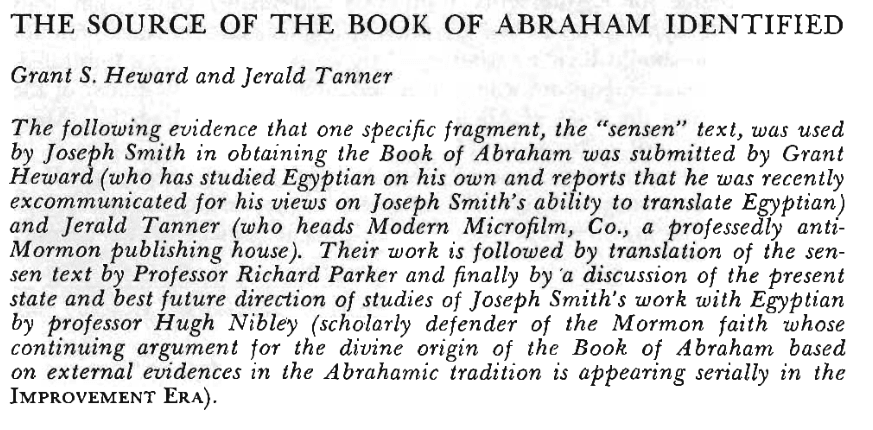
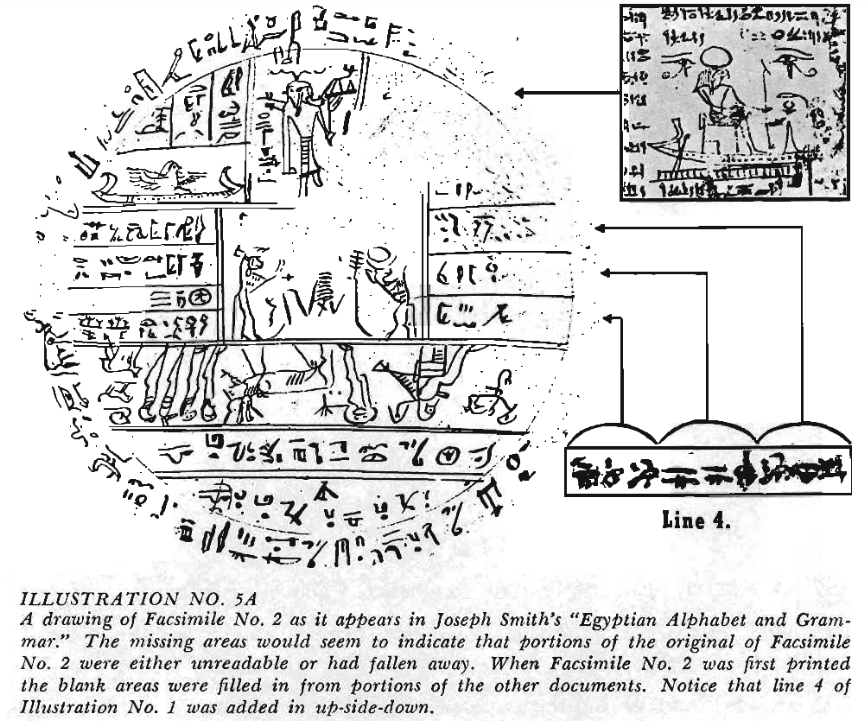
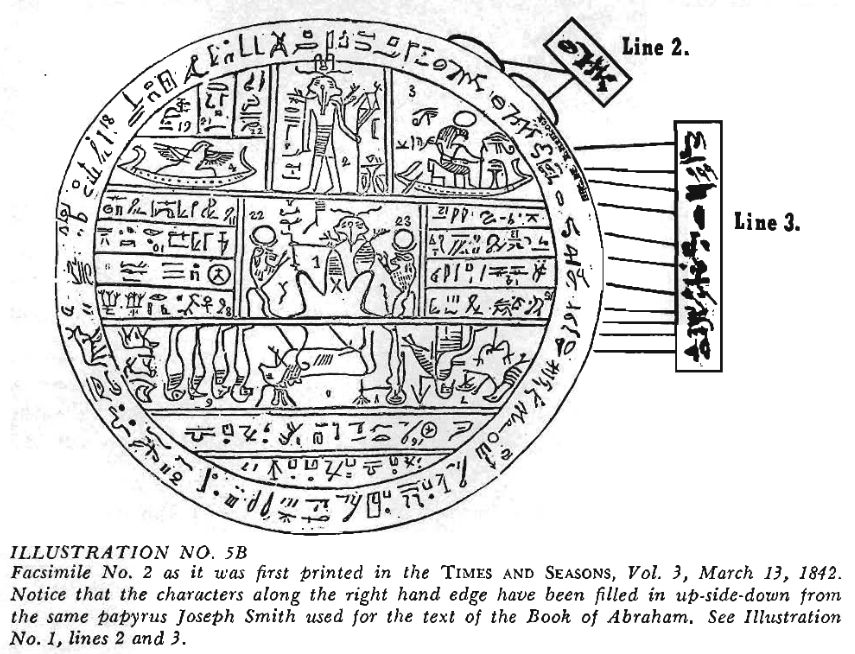
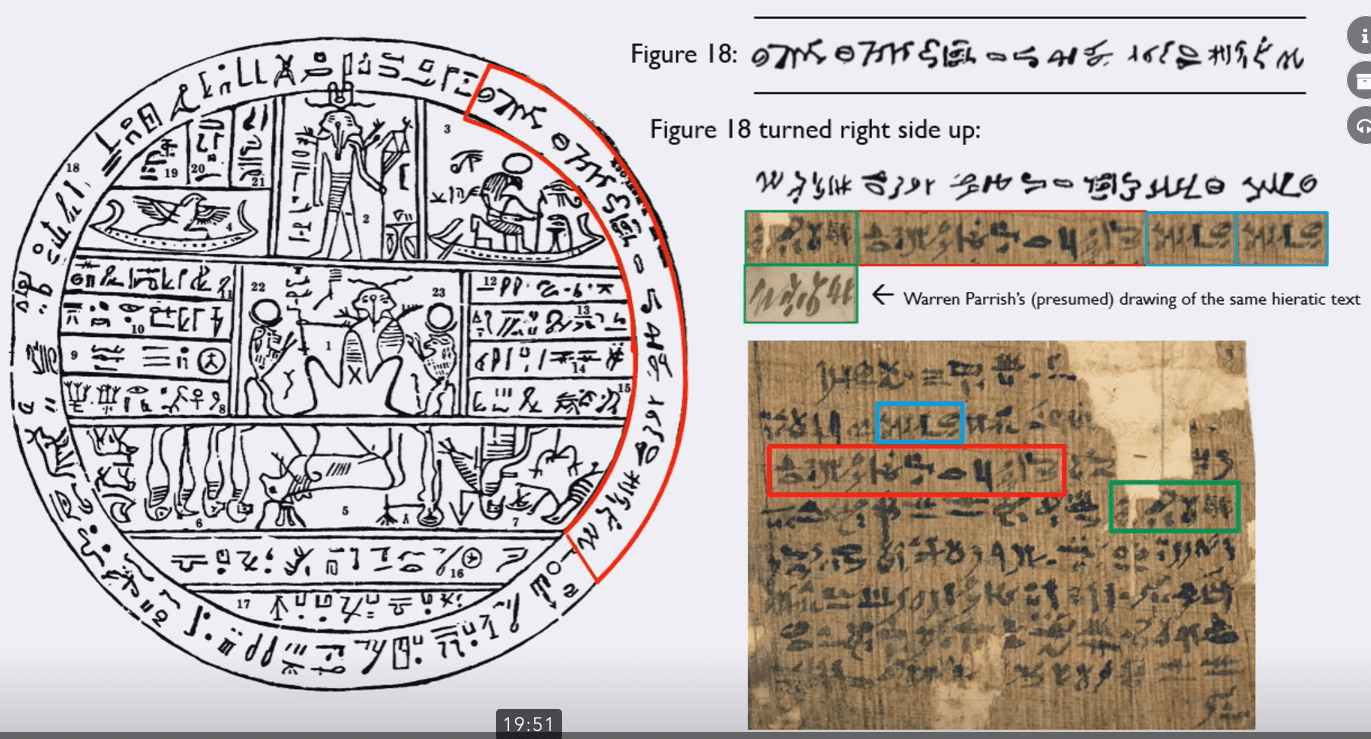
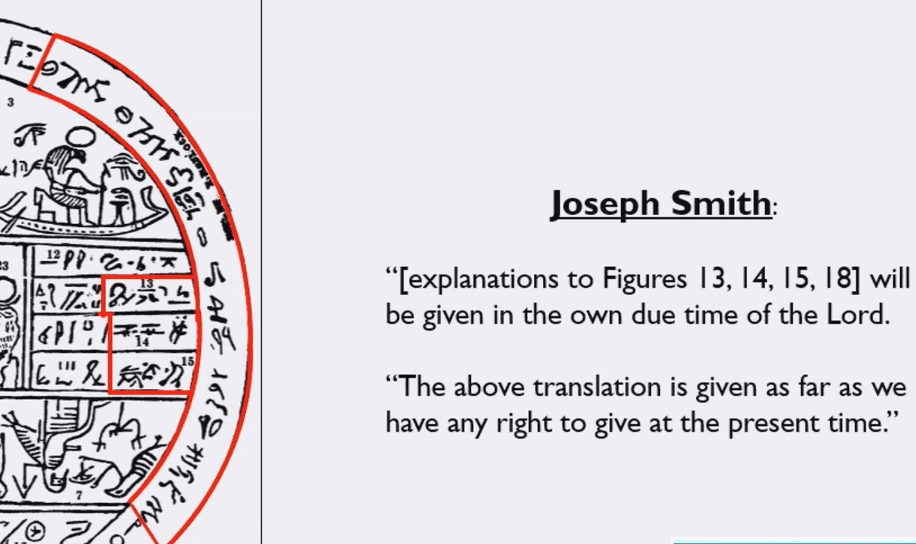
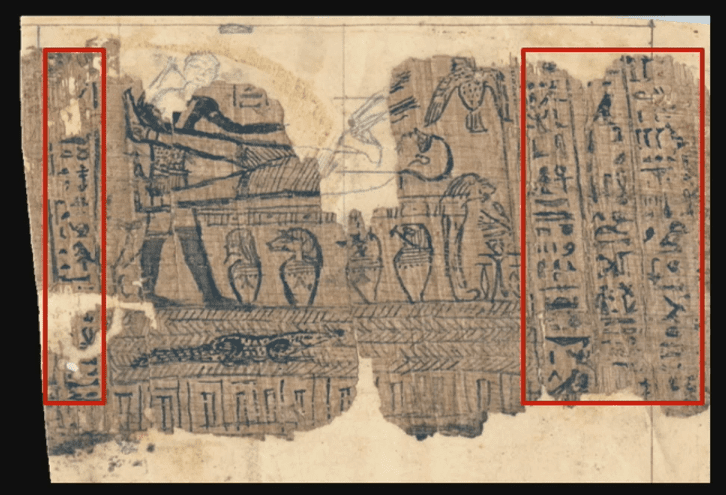

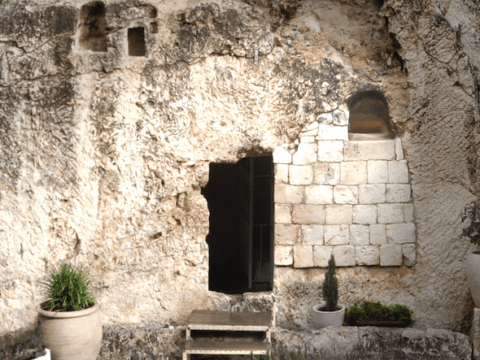







How do you explain that the explanations given for each facsimile don’t match any Egyptologist translation of those sections? I am afraid that even the church essays suggest he didn’t really translate an ancient text, but was inspired by one that has nothing to do with Abraham. It is much easier to show that it is pseudonymous writings by Joseph, like the book of Moses, than actually an ancient text. If you are inspired by it, great. But these convoluted arguments to me don’t prove anything.
Egyptologists are experts on how Ancient Egyptians would interpret things, they aren't experts on how ancient jews would interpret the same things.
Jeff is a good apologist. He ignores evidence that he can’t explain away.
“Egyptologists are experts on how Ancient Egyptians would interpret things, they aren't experts on how ancient jews would interpret the same things.”
This seems nonsensical. Are you saying ancient Jews would choose to write in Egyptian, then provide their own meanings for the writings they produced? Are there other examples showing this was a common practice? Why not just write in Hebrew?
Also, is there any evidence that the text of the papyri was written by a Hebrew and not an Egyptian?
This comment has been removed by a blog administrator.
Let's assume that the papyri purchased by Smith, or some portion of them, are everything Smith claimed them to be. That would mean the Church had in its possession the only extant copy of an incredibly important and otherwise completely unattested ancient text, an absolute treasure on the order of the Dead Sea scrolls.
So why did the Church let this incredibly valuable artifact slip away? We know very little about how the papyri were handled before Emma sold them off in 1856, but what we do know gives us no evidence they were treated with the reverence one would expect from people who genuinely believed them to be the words of Abraham written by his own hand upon papyrus.
So what gives? Is it possible the papyri were so cavalierly handled because the people handling them didn't really believe in their authenticity?
Makes you wonder.
— OK
It is interesting to note that none of the comments thus far have addressed the merits or possible errors in Jeff's post.
Anon@3:50, there was one place in ancient Egypt that for a brief time showed remarkable interest in Jewish lore. That place was Thebes around 100 BC plus or minus a century. If there was a Jewish Book of Abraham text written in Egyptian and adapting Egyptian lore and figures, it would have most likely come from that time and place — which very coincidentally corresponds with the time and place of the papyri obtained by Joseph Smith. The owner of the papyri, Hor, was an ancient priest who would have been the right person in the right time and place to have access to and interest in something like the Book of Abraham — if it existed, of course. Part of the access that Egypt had to Jewish lore came from Jewish colonies in Egypt (e.g, Elephantine and others).
Key theories related to the Book of Abraham hold that it was a Jewish text that had been converted into Egyptian, either by a Jewish redactor or by an Egyptian scribe/priest who was fascinated with and familiar with Jewish lore. Understanding of the Book of Abraham facsimiles must begin with considering the possibility that classic Egyptian themes have been adapted to tell a Jewish story. So Facsimile 1, while it may look like a classic image associated with mummification, should be considered differently. In fact, look, the person isn't dead, but very much alive. His leg and hands are up as if trying to escape from the altar. In fact, his posture is exactly the same as that of the Egyptian hieroglyph that means prayer or supplication, a perfect way to adapt a funerary scene to Abraham's tale of praying on the altar for deliverance from a priest about to kill him. What seems ordinary at first glance actually has unusual elements that make sense as a way to show part of Abraham's story using by adapting a classic Egyptian vignette. For all the facsimiles, the question is not what did this mean in classic Egyptian lore, but how could this have been adapted for the Book of Abraham.
OK, your comments remind me of how easy it is to fall into the trap of presentism, where we rely on present knowledge and values to judge those of the past. Here your knowledge of the very modern fields of archaeology, the modern discovery of the Dead Sea Scrolls, and the knowledge from modern Egyptology that the Egyptian papyri Joseph had were very unusual (especially if they contained a Book of Abraham), along with the healthy respect of modern academics for ancient artifacts, are used to condemn the Church for its benighted handling of the papyri.
Perhaps you forget that the Church faced a few minor challenges in Nauvoo, such as the assassination of Joseph and Hyrum Smith and the rage of very trendy (for their day) woke mobs driving the Saints out of their homes during a brutally cold winter to flee for their lives. The fine points of negotiating the terms of a good documents preservation policy with Emma Smith seem to have slipped through the cracks, perhaps because the short-sighted leaders at the time were more focused on not being shot and trying to make sure they didn't freeze to death or fall through the ice of the Mississippi River as they crossed it.
Emma, lacking your modern appreciation of the importance of archaeology, Egyptology, the Dead Sea Scrolls, etc., stayed behind and had children to raise and bills to pay. She was not "the Church" that you so love to denounce. She was a mother in poverty and felt the Church had left her rather than the other way around. She had some old papyri in a drawer. What was she supposed to do? Recall also that FedEx and UPS weren't all that reliable back then, so trying to overnight the documents to Church headquarters, if she had been feeling generous and if anyone there recognized how important those documents would be in our day, might have just resulted in accelerating the decay of documents already falling apart or even in their complete loss.
Actually, selling the bulk of the collection to a museum in St. Louis seems like one of the wisest things she could have done to give the documents a chance to benefit scholarship. It's a shame they would later be transferred to a museum in Chicago and apparently burned in the Great Chicago Fire, along with what may have been the long scroll Joseph used to translate the Book of Abraham. "How convenient," you'll say, but that wasn't by design. At least not the Church's design nor Emma's.
Jeff @12:20
But then you fall into the trap of accepting the text as midrash, and being something other than it claims to be (a text written by Abraham). What follows then is the possibility that Joseph created the midrash himself, which theory has been accepted by the church officially as a plausible explanation for the book. What that then means is there is no real relevance to your original post, since there is no direct relationship between the text on the papyri and the text which was produced by Joseph.
Seriously, Jeff? You want us to believe that only moderns like us believe in the importance of preserving ancient records?
Have you forgotten that the importance of preserving ancient records is a prominent theme in the Book of Mormon itself?
To see what I'm getting at, just compare the custodial diligence of the prophets Mormon and Moroni (who kept the plates safe through tumultuous wars) to the carelessness of the prophet Brigham Young, who, in the dozen or so years after Joseph's assassination, never managed to send out a delegation to secure the Book of Abraham for posterity.
Also, of course, Emma did not sell "the bulk of the collection to a museum in St. Louis." She sold the papyri to Abel Combs, a guy just passing through town, a representative of that frontier type noted for its honesty and sober devotion to posterity, the traveling salesman. This is hardly, as you put it, "one of the wisest things she could have done to give the documents a chance to benefit scholarship."
No doubt Emma was bitter about the Church and hard up for money. But these are just more reasons not to leave such supposedly precious artifacts in her possession.
Anyway, to recap:
The most likely explanation for the careless handling of the papyri is not the tumult of the times or the difficulties of travel. Salt Lake City is not Mars; it would not have been so hard to send a delegation to Nauvoo with the aim of securing the papyri.
Nor is the most likely explanation the lack of any example of the value of preserving ancient documents. Such examples abound in the Book of Mormon.
Nor is the most likely explanation Emma's supposed desire to find a better home for the papyri in a museum. She sold them to a traveling salesman.
What is the most likely explanation? We shouldn't rule out the possibility that leaders like Brigham devalued this material because they never believed in its authenticity in the first place. To put it a little too bluntly, they were in on the con.
— OK
An easier solution would have been to destroy them, then claim they were taken back into heaven by Abraham. :^)
I can see the argument for the thought that once, translated, the original artifacts weren't as useful anymore. I'm not sure that 19th century Americans were particularly into relics and their preservation.
Your argument is that Joseph didn’t translate the parts that were filled in by the illustrator and thus it is true vs the parts he translated that have been shown to be translated incorrectly and so his text isn’t a translation but at best inspired
Anon @ 2:48 is right. It would have been easier to do away with the fragments. It would have been even easier to refuse to create the KEP and other documents and instead just run the Book of Abraham text off like he did with the Book of Mormon. To me, the KEP is a riddle, but it's very existence inclines me to believe that opportunistic fraud is not an explanation. Something like Samuel Morris Brown's thinking or a form of textual glossalalia is more likely.
You don't even need to believe in Joseph Smith's prophecy to believe in glossalalia, which is a concrete and observed phenomenon whatever the ultimate explanation may be.
OK @ 11:55 – You're oversimplifying the situation. Joseph Smith Jr. had been the trustee-in-trust of the Church, which meant that the lines between his property and the Church’s property were blurred. That was one of the reasons why Emma and Brigham devolved into antagonism so fast: they disagreed as to which properties were Joseph’s (and therefore Emma’s) and which belonged to the Church. Brigham didn’t take the papyri because he didn’t have the legal authority to do so, or at least he didn’t have the time to thoroughly assert the Church’s rights to the papyri because, you know, he was supervising an exodus and building a civilization halfway across a continent.
The argument that “Brigham Young didn’t fight for the papyri so he must have not believed in them” is not convincing to start with, and it gets even less so when you consider the actual conditions under which Brigham and Emma were operating.
Also, to be fair, the Book of Mormon authors were writing a record that represented their only chance at being remembered or surviving in any meaningful sense. The pathos is a little different, enough to complicate your case. Preserving your own memory was always important in ancient cultures, as opposed to more academic historiography which is a new innovation.
This comment has been removed by a blog administrator.
Anon @ 1:54 Your logical fallacies are: non sequitur as well as argumentum ad ridiculum with a hefty dose of ad hominem for good measure.
Looks like Brigham is in a damned-if-he-does, damned-if-he-doesn't situation with you, so your imposition of the catch-22 inclines me to not care.
This comment has been removed by a blog administrator.
Heh.
Example: People in the Middle East burned ancient papyrus for fires to be able to cook and for warmth. This has gone on for decades and decades and decades through today. They know they are burning old papers/history or whatever you want to call it. They are trying to survive…they don't care about preserving anything except to survive.
Also countries who conquer other countries destroy the history and culture of the conquered country… they didn't care about preserving anything. ( Like what is happening in the USA and Western world right now)
The Taliban and ISIS destroying everything in their path not related to Islam. Spanish Conquistadors destroying everything they could.
Been happening since the beginning of time.
So to say "non- modern" people knew to preserve historical or ancient texts/ writings / heiroglyphics / art / etc is not logical.
Yes, throughout history a few people who saw the importance of preserving artifacts / historical documents existed, they had amazing foresight, and did what they could.
Anonymous at 2:30, you should provide evidence for claims like the ones you just made. I don't believe you.
OK, my apologies — I forgot that Abel Combs was the one who sold the papyri to the museum. Regardless of who bought them from Emma, I think from her perspective it was reasonable for Emma to sell the papyri, though by our standards and with hindsight regarding their destruction in the Great Chicago Fire, I think we can all agree that it would have been much better to see that they went to scholars who would treat them with care, copy or photograph them, and ensure that they were carefully preserved in a less flammable edifice.
Anon 2:30 writes that People in the Middle East burned ancient papyrus for fires to be able to cook and for warmth…. They know they are burning old papers/history or whatever you want to call it.
Good grief. Even if this were true, it wouldn't mean that people were burning their religious texts. People might have burned all kinds of things, such as old tax records and what have you, but I'll bet they weren't burning copies of the Quran. If I needed to I'd be happy to burn 99 percent of my old files, but that doesn't mean I'd burn the family Bible or my marriage certificate.
Anon 2:30 compounds their illogic by reminding us that countries who conquer other countries destroy the history and culture of the conquered country… they didn't care about preserving anything…. So to say "non- modern" people knew to preserve historical or ancient texts/ writings / heiroglyphics / art / etc is not logical.
But so what? The way that conquerors treat the artifacts of the people they conquer tells us nothing about how we might expect people to handle their own religious artifacts. The fact that the Taliban destroyed ancient Buddhist statues doesn't mean they would destroy an ancient copy of the Quran.
Jeff, from the Historical Introduction to the Joseph Smith Papers Project, here's a bit of evidence that at least some 19th-century Mormons did value the Church's religious artifacts:
"Following the 1837 publication, Cowdery retained possession of the [Book of Mormon] manuscript. Before he died in early 1850 in Missouri, Cowdery charged David Whitmer, his fellow Book of Mormon witness and brother-in-law, with the safekeeping of the manuscript. Many of those who believed in the miraculous origins of the Book of Mormon sought Whitmer out, hoping to view the manuscript. On such occasions, Whitmer confirmed his written testimony of the book’s authenticity, which had been published with the book."
See here.
— OK
I love how the commenters want to totally avoid the topic and the evidence presented that strongly supports the view that those who have contended that JS depended on the KEP and EAG are the basis of the source of the BofA are just wrong.
Late post, but I just discovered this thread. First, thank you Jeff for the kind and complimentary words. It was a real pleasure putting pieces together and delivering this presentation at the FAIR conference. Second, I want to respond to this quotation provided above:
“We shouldn’t rule out the possibility that leaders like Brigham devalued this material because they never believed in its authenticity in the first place. To put it a little too bluntly, they were in on the con.”
I wrote about this subject on my blog back in 2016. The Church did make an effort to acquire the papyri, but were apparently unaware of its demise in the Great Chicago Fire of 1871. Orson Pratt was going to attempt to purchase the papyri from Woods Museum in 1878, but was too late…
https://thebookofabraham.blogspot.com/2016/03/book-of-abraham-manuscripts-and-wood.html